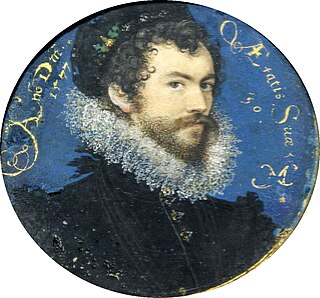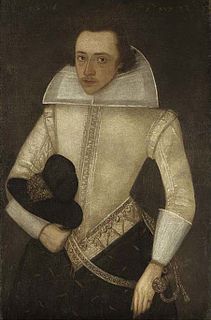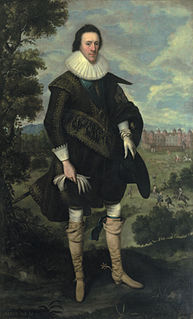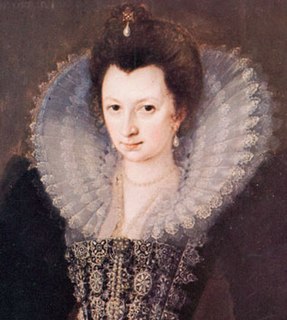Related Research Articles

Nicholas Lanier, sometimes Laniere was an English composer and musician; the first to hold the title of Master of the King's Music from 1625 to 1666, an honour given to musicians of great distinction. He was the court musician, a composer and performer and Groom of the Chamber in the service of King Charles I and Charles II. He was also a singer, lutenist, scenographer and painter.

Henry Carey, 1st Baron Hunsdon KG, was an English nobleman and courtier. He was the patron of Lord Chamberlain's Men, William Shakespeare's playing company. The son of Mary Boleyn, he was a cousin of Elizabeth I.

Emilia Lanier, néeAemilia Bassano, was an English poet in the early modern era. She was the first Englishwoman to assert herself as a professional poet, through a single volume of poems, Salve Deus Rex Judaeorum (1611). Attempts have been made to identify her with Shakespeare's "Dark Lady".

Nicholas Hilliard was an English goldsmith and limner best known for his portrait miniatures of members of the courts of Elizabeth I and James I of England. He mostly painted small oval miniatures, but also some larger cabinet miniatures, up to about ten inches tall, and at least two famous half-length panel portraits of Elizabeth. He enjoyed continuing success as an artist, and continuing financial troubles, for forty-five years. His paintings still exemplify the visual image of Elizabethan England, very different from that of most of Europe in the late sixteenth century. Technically he was very conservative by European standards, but his paintings are superbly executed and have a freshness and charm that has ensured his continuing reputation as "the central artistic figure of the Elizabethan age, the only English painter whose work reflects, in its delicate microcosm, the world of Shakespeare's earlier plays."

Sir Anthony Babington was an English gentleman convicted of plotting the assassination of Elizabeth I of England and conspiring with the imprisoned Mary, Queen of Scots. The "Babington Plot" and Mary's involvement in it were the basis of the treason charges against her which led to her execution. He was a member of the Babington family.

William Carey, of Aldenham, in Hertfordshire was a courtier and favourite of King Henry VIII of England. He served the king as a Gentleman of the Privy chamber, and Esquire of the Body to the King. His wife, Mary Boleyn, is known to history as a mistress of King Henry VIII and the sister of Henry's second wife, Anne Boleyn.

Sir Henry Neville was an English courtier, politician and diplomat, noted for his role as ambassador to France and his unsuccessful attempts to negotiate between James I of England and the Houses of Parliament. In 2005 Neville was put forward as a candidate for the authorship of Shakespeare's works.

William Cecil, 2nd Earl of Salisbury,, known as Viscount Cranborne from 1605 to 1612, was an English peer, nobleman, and politician.
Alfonso Ferrabosco the younger was an English composer and viol player of Italian descent. He straddles the line between the Renaissance and Baroque eras.
Clement Lanier was an English musician and recorder player.
Anthony Bassano was a 16th-century Italian musician.
Jeronimo Bassano was an Italian musician in the Republic of Venice who is notable as the patriarch of a family of musicians: five of his sons, Anthony, Alvise, Jasper, John (Giovanni), and Baptista Bassano, moved from Venice to England to serve in the court of King Henry VIII. They performed as a recorder consort. Jacomo Bassano was his only son to keep his primary residence in Venice. Jeronimo Bassano never moved, and he was listed in Venice as a "Maestro of the trumpets and shawms." He is believed to be the maternal grandfather of composer Giovanni Bassano.
Jerome Lanier was an English musician, sackbut player, son of Nicholas Lanier the Elder, hence uncle of Nicholas Lanier, the artist-musician. Jerome Lanier was appointed in 1599 musician to court of Elizabeth I as Musician in Ordinary on woodwinds and sackbut replacing Mark Anthony Bassano, a post he held until 1643.

Marcus Gheeraerts was a Flemish artist working at the Tudor court, described as "the most important artist of quality to work in England in large-scale between Eworth and Van Dyck" He was brought to England as a child by his father Marcus Gheeraerts the Elder, also a painter. He became a fashionable portraitist in the last decade of the reign of Elizabeth I under the patronage of her champion and pageant-master Sir Henry Lee. He introduced a new aesthetic in English court painting that captured the essence of a sitter through close observation. He became a favorite portraitist of James I's queen Anne of Denmark, but fell out of fashion in the late 1610s.

Elizabeth FitzGerald, Countess of Lincoln, also known as The Fair Geraldine, was an Irish noblewoman and a member of the celebrated FitzGerald dynasty. She became the second wife of Sir Anthony Browne Jr. and later the third wife of English admiral Edward Clinton, 1st Earl of Lincoln. She was the inspiration for The Geraldine, a sonnet written by Henry Howard, Earl of Surrey.

The portraiture of Elizabeth I illustrates the evolution of English royal portraits in the Early Modern period from the representations of simple likenesses to the later complex imagery used to convey the power and aspirations of the state, as well as of the monarch at its head.

Elizabeth Stanley, Countess of Derby, Lord of Mann, was an English noblewoman and the eldest daughter of the Elizabethan courtier and poet Edward de Vere, 17th Earl of Oxford.
Henry Ferrabosco was a court musician before and during the First English Civil War and died a captain in the parliamentary army in Jamaica during the Caribbean expedition.
Mark Anthony Galliardello, probably néAlberti, was a viol player and member of the English Tudor court consort of instruments. Of Italian origin, he settled in London in 1545, remaining in the royal service for the rest of his life. As a conscientious churchwarden who compiled unusually detailed records, he is an important source for scholars of late Tudor church history.
Mary Woodhouse, musician and correspondent of Constantijn Huygens.
References
- Spink, Ian. 2001. "Lanier [Laniere, Laneare, Laneer, Lanyer, Lenear etc.]". The New Grove Dictionary of Music and Musicians, second edition, edited by Stanley Sadie and John Tyrrell. London: Macmillan Publishers.